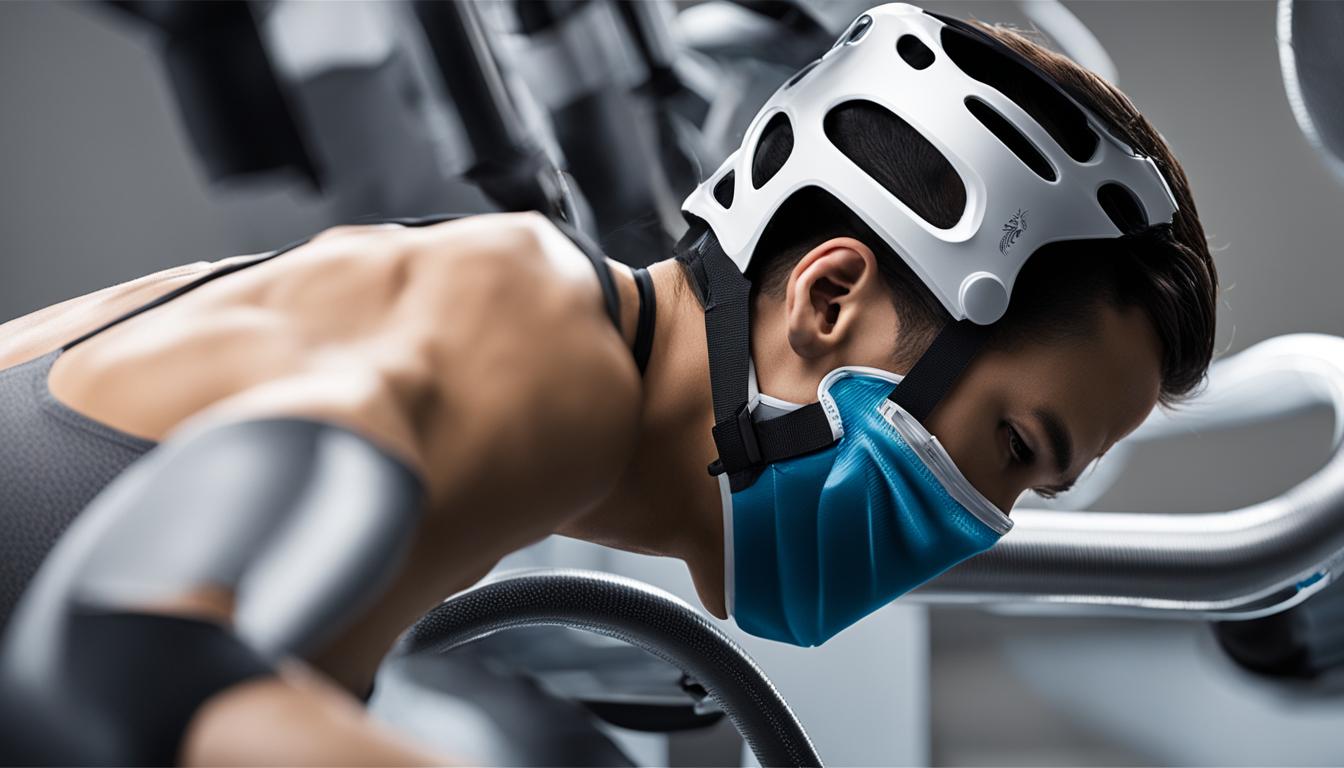If you’re someone who is serious about fitness, chances are you’ve heard of hypoxic training. This training technique, also known as intermittent hypoxic training (IHT), involves creating a low-oxygen environment to push your body’s limits and enhance physical performance. But amidst its rising popularity, one question remains: Is hypoxic training safe?
While some may argue that the benefits of hypoxic training outweigh any potential risks, others express concerns about the dangers it may pose to your health.
In this article, we’ll dive deep into the world of hypoxic training to uncover the truth behind its safety. We’ll explore the potential risks and benefits, discuss important precautions, and provide you with expert insights on how to engage in safe practices for hypoxic training.
So, if you’ve ever wondered whether hypoxic training is safe for you, or if you’re simply curious about the science behind this fitness trend, keep reading to discover everything you need to know.
Key Takeaways:
- Hypoxic training, or intermittent hypoxic training (IHT), involves creating low-oxygen conditions to enhance physical performance.
- When done safely and under proper supervision, hypoxic training can have beneficial effects.
- There are potential risks associated with hypoxic training, such as increased breathlessness and the potential for anemia and muscle loss.
- Following guidelines and precautions is crucial to ensure safe practices during hypoxic training.
- Professional supervision, tailored training programs, and awareness are key factors in promoting safe and effective hypoxic training.
Understanding Hypoxic Adaptation
Adaptation to hypoxia is a natural response of the body to low oxygen levels. When exposed to hypoxic conditions, the body undergoes a series of physiological changes to compensate for the reduced availability of oxygen. Hypoxic training takes advantage of this adaptive response to improve various bodily functions and enhance performance.
During hypoxic training, individuals intentionally expose themselves to periods of low oxygen levels, either during exercise or at rest. This can be achieved through various methods, including hypoxotherapy and intermittent hypoxic training (IHT), where individuals alternate between periods of normal oxygen levels and reduced oxygen levels.
This type of training has shown promise in diverse fields, ranging from sports performance enhancement to neuroprotection and even preventive medicine. Research suggests that hypoxic adaptation can stimulate the production of protective proteins in the brain, enhancing cognitive function and promoting neuroprotection.
“Hypoxic training can elicit various adaptations in the body, leading to improved oxygen utilization, increased red blood cells, enhanced cardiovascular efficiency, and higher cellular energy production.”
Moreover, hypoxic training has been linked to improvements in endurance, cardiovascular fitness, and anaerobic capacity. By subjecting the body to controlled oxygen deprivation, individuals can push their physical limits and achieve greater athletic performance.
The potential benefits of hypoxic training extend beyond sports. Studies have suggested that periodic hypoxic training may have therapeutic effects in conditions such as chronic obstructive pulmonary disease (COPD), diabetes, and hypertension. The application of hypoxic training in preventive medicine and clinical settings continues to be explored, offering new possibilities for improving health and well-being.
Neuroprotection and Cognitive Enhancement
One of the most fascinating aspects of hypoxic training is its potential for neuroprotection and cognitive enhancement. Research indicates that exposure to intermittent hypoxia can stimulate the release of a protein called brain-derived neurotrophic factor (BDNF). BDNF plays a crucial role in the growth and survival of neurons and is associated with improved cognitive function.
A study conducted by researchers at the University of Birmingham found that intermittent hypoxic training improved memory, attention, and motor coordination in healthy individuals. These findings suggest that hypoxic training may have applications not only in sports performance but also in promoting brain health and optimizing cognitive abilities.
Exploring Hypoxic Training Techniques
Hypoxic training encompasses a range of techniques and models that can be customized to individual needs and goals. Some popular forms of hypoxic training include simulated altitude training, hypoxic chambers, and use of specialized hypoxia masks or tents.
Simulated altitude training, often used by athletes, involves training and residing at high altitudes where oxygen levels are naturally lower. This exposure to hypoxic conditions can stimulate adaptation and enhance performance. Hypoxic chambers, on the other hand, artificially replicate low oxygen environments, allowing individuals to control and customize the intensity and duration of hypoxic exposure.
Although hypoxic training holds considerable promise, it is essential to approach it with caution and under proper guidance. The body’s response to hypoxia can vary significantly from person to person, and individualized training programs should be developed to maximize effectiveness while ensuring safety.
The Physiology Behind Hypoxic Blackouts
Hypoxic blackouts, also known as shallow water blackouts, occur when the body is exposed to breath-limiting, high-stress practices in a low-oxygen environment. During hypoxic training, there can be a build-up of carbon dioxide (CO2) in the body, which tricks the brain into not signaling the need to breathe. Without adequate oxygenation, the brain starts to shut down, leading to loss of consciousness. Hypoxic blackouts can result in brain damage and even death within a short period of time. It is important to understand the physiology behind these blackouts to prevent them during hypoxic training.
When the body holds its breath, oxygen deficiency begins to occur. As oxygen levels decrease, the autonomic nervous system, responsible for regulating unconscious bodily functions, detects the rise in carbon dioxide and tries to trigger the breathing response. However, in the case of hypoxic training, the individual is intentionally depriving themselves of oxygen, causing a conflict with the autonomic nervous system.
This conflict disrupts the body’s natural equilibrium and can lead to a shallow water blackout. The act of breath-holding increases carbon dioxide levels in the bloodstream, tricking the brain into thinking that there is sufficient oxygen. This deceptive signal inhibits the brain from initiating the urge to breathe, further reducing oxygen intake and worsening the hypoxic state.
As the oxygen deficiency continues, the brain’s oxygen levels decrease, impairing its ability to function properly. Without sufficient oxygenation, the brain’s cells begin to suffer damage, which can have long-lasting consequences. In the worst-case scenario, a shallow water blackout can result in permanent brain damage or even death.
To prevent hypoxic blackouts during training, it is crucial to prioritize safety and take appropriate precautions. This includes training under professional supervision, following established guidelines, and avoiding prolonged, stressful breath-holding practices. By understanding the physiological mechanisms at play and implementing safe practices, athletes can maximize the benefits of hypoxic training while minimizing the risk of hypoxic blackouts.
The Dangers of Hypoxic Training
Hypoxic training, if not done safely, can pose risks and dangers to individuals. One of the most serious concerns is the occurrence of shallow water blackout, which can lead to a loss of consciousness and potential drowning. This phenomenon is caused by a sudden drop in blood oxygen levels resulting from prolonged breath-holding during hypoxic training.
To minimize health risks associated with hypoxic training, it is essential to implement proper safety measures and professional monitoring. Amateur athletes who engage in hypoxic training without adequate supervision and monitoring face increased health risks and the potential ineffectiveness of their training efforts.
Professional monitoring plays a vital role in ensuring the safety and effectiveness of hypoxic training. Through regular monitoring of physiological responses, professionals can closely track an athlete’s oxygen saturation levels, heart rate, and respiratory rate. This allows them to intervene promptly if any adverse effects or dangers arise during the training sessions.
It is important for individuals engaging in hypoxic training to understand and follow safety measures to prevent accidents and ensure their well-being. These safety measures include:
- Never training alone; always have a knowledgeable partner or trainer present
- Using safety equipment, such as lifeguards or flotation devices, especially during water-based hypoxic training
- Listening to your body and not pushing beyond your limits
- Gradually increasing the intensity and duration of the training sessions
- Seeking professional guidance and supervision to tailor training programs to your individual needs
By adhering to these safety measures and receiving professional guidance, individuals can mitigate the risks associated with hypoxic training and ensure a safer and more effective training experience.
Balancing Safety and Effectiveness in Hypoxic Training
Finding the balance between safe hypoxic training practices and effectiveness is crucial to optimize results while minimizing risks. Research has shown that training with moderate hypoxia and a low cycle frequency can lead to favorable effects on physical performance and physiological adaptations.
One approach that has gained attention is low-dose hypoxic training, which involves exposing the body to mild levels of hypoxia for short durations. This approach allows for a safer hypoxic training experience while still reaping the benefits. By avoiding severe hypoxia and frequent episodes, the risk of developing pathological conditions can be reduced.
It’s important to understand that individual physiological responses to hypoxic training can vary. What works for one athlete may not be as effective for another. Therefore, it is crucial to customize training programs to suit each individual’s specific needs and capabilities.
Professional supervision and monitoring are essential components of safe and effective hypoxic training. Having a qualified expert overseeing the training sessions ensures that the individual’s physiological responses are closely monitored and any potential risks can be identified and addressed. Additionally, professional supervision helps athletes understand the correct techniques and practices to follow during hypoxic training, promoting safe practices and minimizing the chances of accidents or health complications.
To summarize, safe and effective hypoxic training involves utilizing low-dose hypoxia, tailoring training programs to individual physiological responses, and receiving professional supervision and monitoring. By finding the right balance between safety and effectiveness, athletes can optimize the benefits of hypoxic training while minimizing potential risks.
| Benefits of Balancing Safety and Effectiveness in Hypoxic Training | Key Points |
|---|---|
| Maximized results | – Training with moderate hypoxia and low cycle frequency can lead to favorable effects on physical performance |
| Risk reduction | – Avoiding severe hypoxia and frequent episodes can help prevent pathological conditions |
| Customized approach | – Tailoring training programs to individual physiological responses optimizes effectiveness |
| Professional guidance | – Supervision and monitoring ensure safe practices and minimize health risks |
Awareness and Education for Safe Hypoxic Training
Coaches and trainers play a crucial role in promoting safe hypoxic training practices by raising awareness and providing education to athletes. It is their responsibility to ensure that athletes understand the potential dangers and safety precautions associated with hypoxic training.
By setting ground rules and emphasizing safe practices, coaches can prevent excessive breath-holding and educate athletes about the importance of listening to their body’s signals. Athletes should never be encouraged to resist the urge to breathe or rewarded for prolonged breath-holding, as this can lead to serious health risks.
Through awareness and education, coaches can help prevent tragedies related to hypoxic training. By educating athletes about the risks and providing guidance on safe practices, coaches can empower athletes to make informed decisions about their training and prioritize their well-being.
“Education is the most powerful weapon which you can use to change the world.”
– Nelson Mandela
The Coaches’ Responsibility
Coaches have a responsibility to stay informed about the latest research and guidelines regarding hypoxic training. They should be equipped with the knowledge to recognize signs of oxygen deficiency and be trained in appropriate safety measures.
In addition to educating athletes, coaches should also be aware of regulatory measures in place to ensure safe practices during hypoxic training. Understanding the importance of regulation and compliance helps coaches create a safe training environment and mitigate potential risks.
Preventing Tragedies Through Education
Education is a powerful tool in preventing tragedies related to hypoxic training. Coaches can incorporate educational sessions into training programs, where athletes learn about the risks, safe practices, and the importance of seeking professional supervision during hypoxic training.
By proactively educating athletes, coaches not only protect their health but also empower them to make informed decisions. This creates a culture of safety and responsibility surrounding hypoxic training.
Hypoxic Training Safety Measures
| Safety Measures | Description |
|---|---|
| Professional Supervision | Athletes should undergo hypoxic training under the supervision of qualified professionals who can monitor their physiological responses and ensure safety. |
| Educational Sessions | Incorporate educational sessions where athletes learn about the risks, safe practices, and importance of seeking professional guidance during hypoxic training. |
| Open Communication | Create an environment where athletes feel comfortable discussing any concerns or difficulties they may experience during hypoxic training. |
| Regular Evaluation | Periodically assess the progress and physiological response of athletes to ensure the training program is safe and effective. |
By implementing these safety measures and promoting awareness and education, coaches can significantly reduce the risks associated with hypoxic training and ensure the well-being of their athletes.

Professional vs. Amateur Approaches to Hypoxic Training
When it comes to hypoxic training, there is a significant difference between the approaches of professional athletes and amateur athletes. Professional athletes, with their consistent access to resources and specialized supervision, take a more cautious and comprehensive approach to their training. They understand the importance of considering various factors such as nutrition, monitoring their physiology, and utilizing specific hypoxic training methods to maximize their physical performance.
On the other hand, amateur athletes often rely on generic training programs and lack the specialized supervision that professionals enjoy. Without the guidance of professionals, they may overlook crucial aspects of hypoxic training such as proper monitoring and personalized adjustments to accommodate their individual physiological responses.
Hence, the difference in approach between professionals and amateurs not only affects their performance but also impacts their overall safety. Professionals, with their emphasis on monitoring and physiological understanding, are better positioned to mitigate potential health risks associated with hypoxic training. Amateurs, who engage in hypoxic training without expert supervision, may unknowingly expose themselves to increased health risks.
The Importance of Monitoring
Monitoring plays a critical role in hypoxic training as it allows athletes to track and analyze their physiological responses, enabling them to make informed decisions about their training intensity and duration. Professional athletes have access to advanced monitoring tools and technologies that provide real-time data on key physiological markers. This enables them to fine-tune their training programs and ensure optimal results while minimizing health risks.
Amateurs, however, often lack access to such monitoring resources and may not fully understand how to interpret and analyze their physiological responses during hypoxic training. This makes it challenging for amateurs to gauge the effectiveness of their training and increases the likelihood of inefficient and potentially unsafe practices.
Physiology and Performance Optimization
Understanding the physiology behind hypoxic training is vital for optimizing both safety and performance. Professional athletes benefit from detailed knowledge of the physiological mechanisms involved in hypoxia adaptation. Armed with this understanding, they can tailor their training programs to suit their individual physiological needs, ensuring that the hypoxic stimulus is appropriate and effective.
Amateur athletes, without the guidance of professionals, may struggle to grasp the intricacies of hypoxia adaptation and the physiological response to hypoxic training. As a result, their training methods may be less targeted, less effective, and potentially riskier due to inadequate adjustments to their individual physiology.
Quote: “Professional athletes have access to specialized supervision, monitoring tools, and knowledge that amateurs often lack. This puts professionals in a better position to optimize their hypoxic training, ensuring both safety and performance improvements.” – Dr. James Mitchell, Sports Physiologist
Maximizing the Potential of Hypoxic Training
While professional athletes have the advantage of specialized support, amateurs can still make their hypoxic training safer and more effective by seeking professional guidance and developing a comprehensive understanding of the training methods they use. By working with experienced coaches or sports scientists, amateurs can ensure proper monitoring, personalized adjustments to training programs, and knowledge of safe and effective hypoxic training techniques.
By approaching hypoxic training in a professional manner, even amateurs can maximize the benefits and minimize the risks associated with this training method, ultimately improving their physical performance.
| Professional Athletes | Amateur Athletes |
|---|---|
| Access to specialized supervision and monitoring | Lack of specialized supervision and monitoring |
| Utilization of specific hypoxic training methods | Relying on generic training programs |
| Consideration of nutrition and personalized adjustments | Limited understanding of individual physiological responses |
| Optimization of safety and performance | Potential for increased health risks and inefficiencies |
Tailoring Hypoxic Training and Setting Realistic Expectations
When it comes to hypoxic training, a one-size-fits-all approach is not effective. It is crucial to tailor the training program to each individual’s physiological response and capabilities. By customizing the training to match an athlete’s specific needs, we can optimize the benefits while minimizing potential risks.
One key aspect of tailoring hypoxic training is setting realistic expectations. It’s important to understand that the extent of physical improvement may vary among athletes. Higher-level athletes who are already at peak performance may have less room for improvement compared to amateurs or beginners.
To optimize the effectiveness of hypoxic training, it is essential to evaluate individual physiological and physical responses. By monitoring heart rate, oxygen saturation levels, and other relevant factors, we can better understand how each athlete responds to hypoxia and adjust the training accordingly.
Evaluating physiological response
Assessing an athlete’s physiological response is crucial for designing an effective hypoxic training program. Understanding how the body adapts to low oxygen levels allows us to create individualized training plans that target specific areas for improvement.
“By evaluating an athlete’s physiological response, we can determine the optimal level of hypoxia and cycle frequency to maximize the training effects while ensuring safety.”
For some athletes, a higher degree of hypoxia may be necessary to elicit the desired physiological adaptations. Others may benefit more from low-dose hypoxic training. It’s important to work closely with athletes and monitor their progress to ensure they are not pushed beyond their limits.
Setting realistic expectations
Setting realistic expectations is crucial to avoid disappointment and maintain motivation during hypoxic training. While hypoxic training can lead to significant improvements in aspects such as endurance, speed, and recovery, athletes need to understand that the rate and extent of improvement may vary.
“By setting realistic expectations, athletes can focus on continuous progress rather than unrealistic goals, leading to a more positive and sustainable training experience.”
It’s important to communicate openly with athletes about the potential benefits and limitations of hypoxic training. By managing expectations, we can help athletes stay motivated and committed to their training regimen.
Overall, tailoring hypoxic training to each athlete’s physiological response and setting realistic expectations are key to optimizing the effectiveness of training. By understanding individual differences and monitoring progress, we can ensure that athletes achieve their goals while minimizing potential risks.
Conclusion: Promoting Safe and Effective Hypoxic Training
To ensure safe and effective hypoxic training, it is crucial to prioritize safe practices, seek professional supervision, and provide education on the potential risks and precautions involved. Hypoxic training can offer numerous benefits when done correctly, but it is essential to understand the importance of tailored training programs to optimize results and minimize health risks.
Professional supervision plays a vital role in ensuring the safety and effectiveness of hypoxic training. Working with qualified trainers and coaches who understand the physiological responses to hypoxia can help athletes train within their limits and prevent accidents. Education also plays a key role in promoting awareness and informing athletes about safe hypoxic training practices.
By tailoring training programs to each individual’s physiological response, athletes can optimize the benefits of hypoxic training. Every person is unique, and understanding their specific needs and limitations is crucial for achieving desired results. It is also important to set realistic expectations and acknowledge that different individuals may have varying levels of improvement.
In conclusion, creating a culture of safe and effective hypoxic training practices requires a combination of safe practices, professional supervision, education, and tailored training programs. By implementing these measures and promoting awareness, athletes can enjoy the benefits of hypoxic training while minimizing potential risks.



